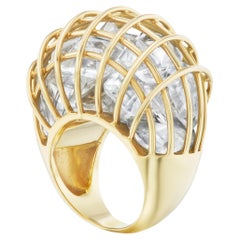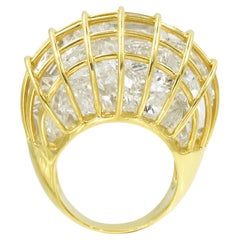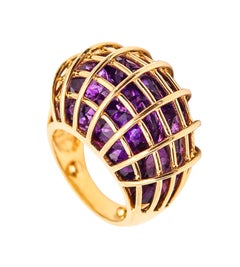Verdura Cage Ring
Early 2000s American Modern Cocktail Rings
Rock Crystal, 18k Gold
Recent Sales
21st Century and Contemporary Cocktail Rings
Yellow Gold
20th Century Italian Modernist Cocktail Rings
Amethyst, Gold, Yellow Gold, 18k Gold
21st Century and Contemporary Italian Cocktail Rings
Crystal, 18k Gold
People Also Browsed
1990s Structured Shoulder Bags
21st Century and Contemporary Evening Dresses
1970s French Evening Dresses
20th Century Unknown Coats and Outerwear
1960s North American Cropped Jackets
1960s Italian Evening Bags and Minaudières
21st Century and Contemporary French Structured Shoulder Bags
2010s Evening Bags and Minaudières
21st Century and Contemporary Unknown Structured Shoulder Bags
1960s French Cocktail Dresses
21st Century and Contemporary Evening Gowns
Early 2000s Evening Dresses and Gowns
2010s Italian Crossbody Bags and Messenger Bags
2010s French Clutches
1990s French Belts
2010s French Structured Shoulder Bags
Verdura for sale on 1stDibs
Fulco di Verdura (1898–1978) is not exactly a household name, except for those who know a thing or two about highly original, often eccentric handcrafted earrings and bracelets, and, even more so, for those fortunate enough to own some. In that exclusive group, Verdura is regarded as the most gifted and coveted designer of his time.
Verdura was born in Sicily in 1898, the scion of a noble family related to the Lampedusas. (His cousin, Giuseppe di Lampedusa, wrote the great Italian saga The Leopard). His life was charmed from birth. Raised in his family’s villa, he grew up during a time when Sicily, and Palermo in particular, were meccas for well-born and highly cultured European travelers.
A bona fide duke with no clear ambitions but creative leanings aplenty (he could draw and paint), the young Verdura was part of the wandering social circuit — the so-called beau monde — that went from capital to capital, resort to resort.
Verdura, though small in stature, had that indefinable quality called charm. As a result, he was the life of every party he attended. When he finally started designing jewelry under Coco Chanel in the late 1920s, many of his friends became his clients (or received the pieces as gifts).
Elsa Maxwell took him under her ample wing when she was hired to do public relations for the Lido in Venice and introduced him to the local and visiting cognoscenti. Chanel, whom he met in Venice, hired him to work in the textiles division of her fashion house. But it was his flair for jewelry that soon caught Coco’s eye. Eventually, he rose to become her personal designer of fine jewelry.
In 2002’s Verdura: The Life and Work of a Master Jeweler (Thames & Hudson), Vanity Fair’s Amy Fine Collins describes the sensation of wearing pieces by Verdura, who drew inspiration from nature for his signature gem-studded seashell brooches and honeybee earrings.
“They were ingeniously calculated to flatter the wearer,” writes Collins. “Earrings undulated to complement the convolutions of an earlobe, rings seductively followed the phalanges of a finger, and necklaces gracefully traced the anatomy of the throat.”
In 1934, Verdura left Chanel and together with two friends, aspiring actress Princess Natalia Pavlovna Paley and Baron Nicholas de Gunzburg, moved to the U.S. After several stops, he found a job through Diana Vreeland in Hollywood with Paul Flato, then the “jeweler to the stars.” Soon he was signing his work and helping Flato cultivate the crème de la creme of the silver screen — those both on it and behind it.
Verdura left Los Angeles for New York and opened his own salon, first on Fifth Avenue in 1939, just as World War II was beginning in Europe. His backers were Vincent Astor and Cole Porter, for whom he made bejeweled boxes and cigarette cases — gifts from Porter’s wife, Linda — to commemorate the opening nights of several musicals.
Verdura began to expand both his repertoire — he became much more daring and flamboyant — and his clientele. The Duchess of Windsor, Daisy Fellowes, Greta Garbo and others routinely gave him commissions. In 1941, Verdura collaborated on a collection of six pieces with Salvador Dalí to accompany a Dalí exhibition at the Museum of Modern Art. Verdura retired in 1972 and left the care of the company to his partner, Joseph Alfano. He later moved to London, where he died in 1978 at the age of 79.
Among the most prized pieces on display in a 2014 Verdura jewelry exhibition in New York were Greta Garbo’s curb-link bracelet watch, which Verdura designed for her in 1939; Coco Chanel’s pair of Maltese Cross cuff bracelets (she wore one on each wrist); and Diana Vreeland’s duo of Byzantine brooches.
Find a range of vintage Verdura jewelry today on 1stDibs.
Why Gold Shines in Jewelry Craftsmanship
Gold is the feel-good metal, the serotonin of jewelry. Wear vintage and antique gold necklaces, watches, gold bracelets or gold rings and you feel happy, you feel dressed, you feel, well, yourself.
Gold, especially yellow gold, with its rich patina and ancient pedigree going back thousands of years, is the steady standby, the well-mannered metal of choice. Any discussion of this lustrous metal comes down to a basic truth: Gold is elementary, my dear. Gold jewelry that couples the mystique of the metal with superb design and craftsmanship achieves the status of an enduring classic. Many luxury houses have given us some of our most treasured and lasting examples of gold jewelry over the years.
Since its founding, in 1837, Tiffany & Co. has built its reputation on its company jewelry as well as its coterie of boutique designers, which has included Jean Schlumberger, Donald Claflin, Angela Cummings and Elsa Peretti. There are numerous gold Tiffany classics worth citing. Some are accented with gemstones, but all stand out for their design and the workmanship displayed.
For the woman who prefers a minimalist look, the Tiffany & Co. twist bangle (thin, slightly ovoid) is stylishly simple. For Cummings devotees, signature pieces feature hard stone inlay, such as her pairs of gold ear clips inlaid with black jade (a play on the classic Chanel black and tan), or bangles whose design recalls ocean waves, with undulating lines of lapis lazuli and mother-of-pearl. And just about any design by the great Jean Schlumberger is by definition a classic.
Even had he eschewed stones and diamonds, Southern-born David Webb would be hailed for the vast arsenal of heavy gold jewelry he designed. Gold, usually hammered or textured in some manner, defines great David Webb jewelry. The self-taught jeweler made very au courant pieces while drawing inspiration from ancient and out-of-the-way sources — East meets West in the commanding gold necklaces made by Webb in the early 1970s. The same could be said for his endlessly varied gold cuffs.
In Europe, many houses have given us gold jewelry that sets the highest standard for excellence, pieces that were highly sought after when they were made and continue to be so.
Numerous designs from Cartier are homages to gold. There are the classic Trinity rings, necklaces and bracelets — trifectas of yellow, white and rose gold. As a testament to the power of love, consider the endurance of the Cartier Love bracelet.
Aldo Cipullo, Cartier’s top in-house designer from the late 1960s into the early ’70s, made history in 1969 with the Love bracelet. Cipullo frequently said that the Love bracelet was born of a sleepless night contemplating a love affair gone wrong and his realization that “the only remnants he possessed of the romance were memories.” He distilled the urge to keep a loved one close into a slim 18-karat gold bangle.
BVLGARI and its coin jewelry, gemme nummarie, hit the jackpot when the line launched in the 1960s. The line has been perennially popular. BVLGARI coin jewelry features ancient Greek and Roman coins embedded in striking gold mounts, usually hung on thick link necklaces of varying lengths. In the 1970s, BVLGARI introduced the Tubogas line, most often made in yellow gold. The Tubogas watches are classics, and then there is the Serpenti, the house's outstanding snake-themed watches and bracelets.
A collection called Monete that incorporated the gold coins is one of several iconic BVLGARI lines that debuted in the 1970s and ’80s, catering to a new generation of empowered women. Just as designers like Halston and Yves Saint Laurent were popularizing fuss-free ready-to-wear fashion for women on the go, BVLGARI offered jewels to be lived in.
Since Van Cleef & Arpels opened its Place Vendôme doors in 1906, collection after collection of jewelry classics have enchanted the public. As predominantly expressed in a honeycomb of gold, there is the Ludo watch and accessories, circa the 1920s, and the golden Zip necklace, 1951, whose ingenious transformation of the traditional zipper was originally proposed by the Duchess of Windsor. Van Cleef's Alhambra, with its Moroccan motif, was introduced in 1968 and from the start its popularity pivoted on royalty and celebrity status. It remains one of VCA’s most popular and collected styles.
Mention must be made of Buccellati, whose name is synonymous with gold so finely spun that it suggests tapestry. The house’s many gold bracelets, typically embellished with a few or many diamonds, signified taste and distinction and are always in favor on the secondary market. Other important mid-20th-century houses known for their gold-themed jewelry include Hermès and Ilias Lalaounis.
Find a stunning collection of vintage and antique gold jewelry on 1stDibs.
Finding the Right Cocktail-rings for You
A flashy symbol of wealth during the early 20th century, antique and vintage cocktail rings have gained broader appeal in the decades since for the hefty dose of glamour they bring to any ensemble.
Cocktail rings earned their name for their frequent appearances during glitzy cocktail parties at the height of the Prohibition era. Back then, these accessories were seen not only as statement pieces but as statements in and of themselves. They openly represented a sense of freedom and independence as well as a demonstration of opulence. After all, the 1920s heralded the Harlem Renaissance and Art Deco design, and a slew of social and cultural shifts meant that women in particular were breaking from pre–World War I conventions and embracing newfound freedoms to express themselves as individuals.
Women expressly wore cocktail rings on the fingers of their right hand versus the left, which was “reserved” for an engagement ring or wedding band, accessories definitely paid for by a suitor. And for cocktail rings, the bigger the colored gem at the center — which is usually mounted in a high setting — and the more elaborate the design, the stronger the likelihood of being noticed.
Cocktail rings remained a popular piece of jewelry for women until the 1930s, when the Great Depression and the onset of war marked a change in behaviors nationwide. While the 1960s and ’70s saw a return in visibility for the accessory, it wasn’t until the 1980s that cocktail rings once again assumed their position as a beacon of luxury and glitz.
During the 20th century, the range of dazzling cocktail rings seems to have been limitless, from glimmering gold rings set with carved jade diamonds designed by David Webb to Pomellato’s pink quartz confections to striking Gucci butterfly rings with accent diamonds set in a pavé fashion.
So, how do you wear a cocktail ring? Cocktail rings “can be worn for almost anything — dinners, date nights, parties, special events, on the red carpet,” explains David Joseph of New York-based jewelry brand Bochic.
Can you wear cocktail rings with other rings? “In my opinion, cocktail rings should stand on their own since they showcase a large gem in the center,” says Joseph.
These glamorous jewels can be worn inside or outside crowded taverns, in either daytime or nighttime with casual or dressy attire. On 1stDibs, find a wide variety of antique and vintage cocktail rings, including those offered by Chanel, whose elegant cocktail rings often feature pearls and, of course, diamonds, and sometimes were styled after showy flowers like the camellia, and Van Cleef & Arpels, whose detailed and intricate designs are viewed as miniature pieces of wearable art.


